Preparing a layer cake for decorating
Here’s a skill that every aspiring baker needs to master. The good news is it isn’t difficult, especially if you work with pre-made and pre-frozen layers. Take the crumbles and tears out of the process and it becomes, well, a cake-walk (sorry).
So then, armed with two frozen 9-inch layers, begin by trimming them to shape. Start with the tops if your baked layers are “domed” at all on top, since that will seriously foul up your structure. These layers are nice and flat so I’m not going to bother (though I would if I were planning to brush cake syrup onto them, which I never do, so then I guess I won’t). However since most cake layers emerge from the oven with a slight “flare” at the bottom, I’m going to trim those off.
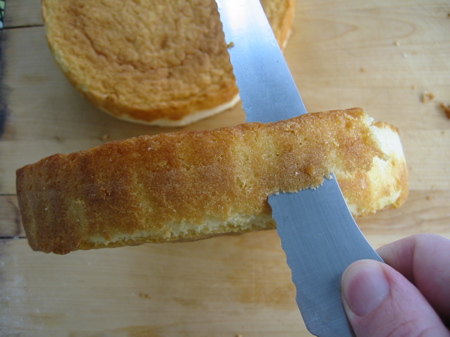
Not all of the brown edge needs to come off, just enough to make the layers roughly square and even, like so:
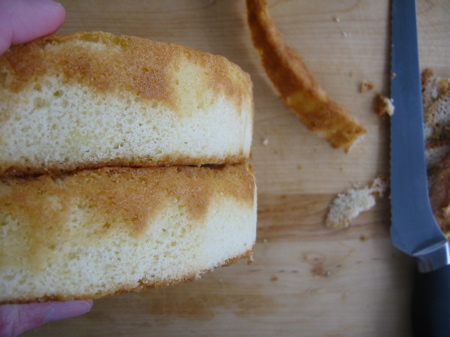
Now then, seizing the closest available cardboard cake circle (ideally one with a wax top), trim it to size. But Joe, can’t I just buy one that’s pre-cut to size? Yes and no. I made 9-inch layers and this is a 9-inch circle, yet the layers emerged from the pan a bit smaller than that. In order to get the edge of the cake flush with the edge of the cardboard base, it needs a little customizing.
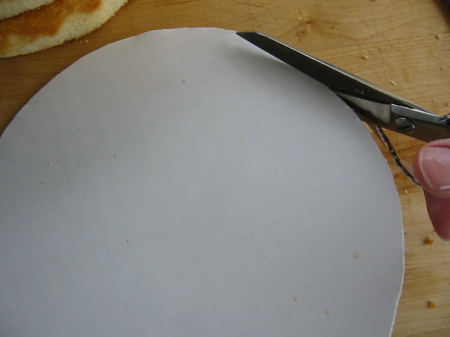
There we go. Don’t worry if the circle isn’t perfectly circular. It’ll eventually get covered with icing anyway. Oh, and did I mention you can make your own base out of scrap cardboard if you want to? You can.
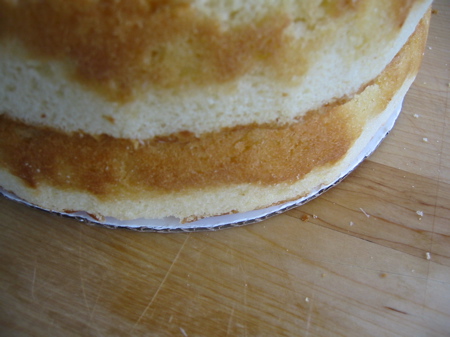
So now, once that’s all squared up, take off your layers and apply a dollop of buttercream. This is will “glue” the cake onto the base.

Replace your bottom layer…
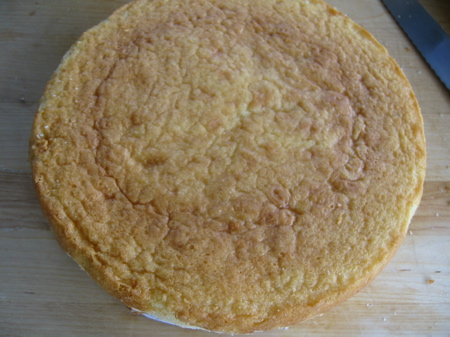
…and apply your filling. This can be anything you want. I’m partial to raspberry, but it can be buttercream, whipped cream, whipped ganache, cooked fruit…ze sky, she iz ze limit. If the cake is going to sit for a ling time, of if you’re concerned about it weeping into the cake, apply a thin scraping up buttercream as a barrier first. Spread the filling around…
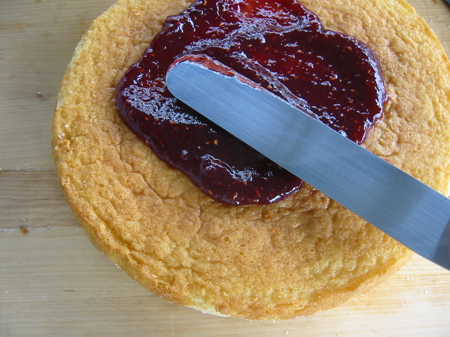
…but be sure to leave about a half-inch of space around the edge. What for? Well, to ensure that your lovely filling doesn’t squirt out the sides of the cake and ruin the look of your icing, that’s what for.
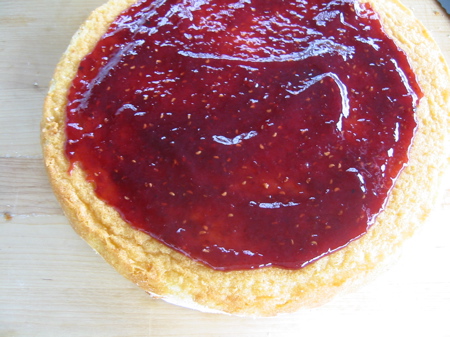
To make extra sure, pipe a “dam” of buttercream around the edge, like so (notice my highly sophisticated pastry bag, courtesy of Ziploc):
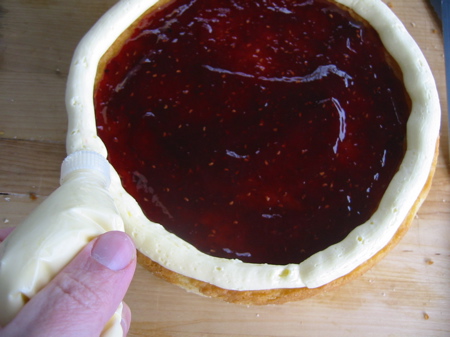
Apply your top layer and push down firmly, until the buttercream oozes out between the layers.

Now it’s time to employ the master baker’s secret weapon: the Ateco revolving cake stand:
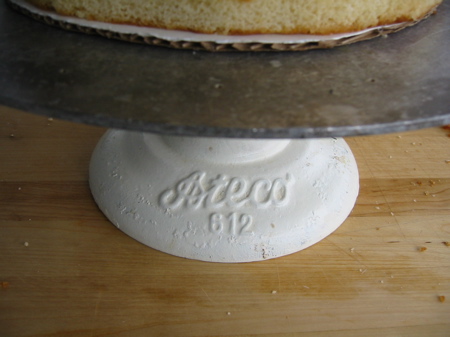
These things are not only amazingly helpful to a cake maker, they’re practically showpieces of industrial art. Just look at that cast iron beauty, will you?
Of course a stand like this is by no means essential. You can easily do without one, but if you aspire to make a lot of cakes, it’s an investment you might want to consider. Buy one new, or source a used one at a restaurant supply store, where it’ll run you about thirty bucks.
So then, plop down your assembled cake…
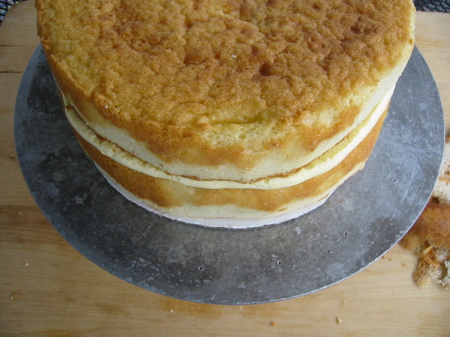
Then a large quantity of buttercream.

Then go at it with your icing spatula…
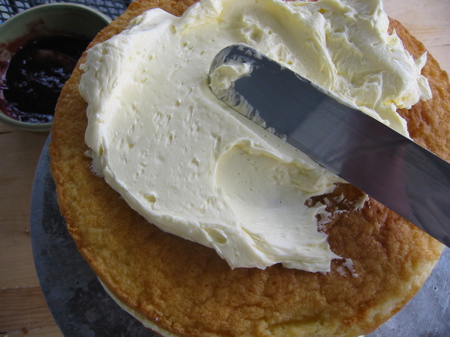
…pressing the buttercream out toward the edge…

…then down along the sides.
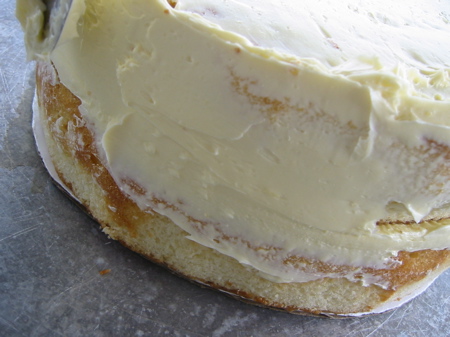
Don’t worry about being neat, however do be firm, since the object here is to press the buttercream into all the nooks and crannies to create a nice flat surface all around.
Once you’re satisfied that you’ve got the cake good and covered, start scraping the icing off. What?? You heard me, start scraping it off. You only want to leave the thinnest possible layer on the cake at this point. It’s what’s called a “crumb coat”. The purpose of course, to stick down any crumbs that might mar the final layer of icing, but even more than that to define the shape of the cake before you start decorating. Not only is it highly functional, it really takes the pressure off the cake maker, since it divides the “structural” and the “ornamental” phases of the cake building process into two separate tasks.
You’ll notice that the cold of the frozen layer will rapidly firm the buttercream that’s in direct contact with the cake. That’s good for a couple of reasons. First, because it glues the whole cake together into a cohesive mass. Second, because a nice firm cake means you can manhandle it a little more. Using your icing spatula, scape the top…
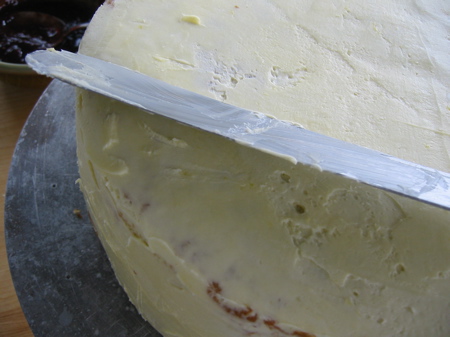
…then the sides:
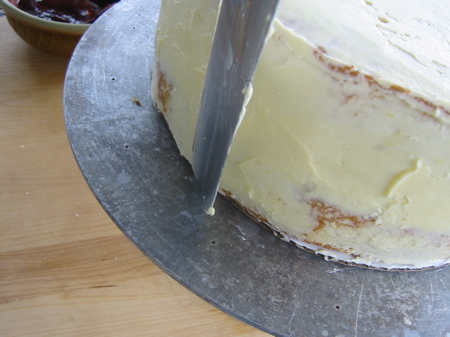
Notice I’m not at all worried about getting a uniform coating on the cake. There are bare spots. But not to worry, the main thing you want to accomplish in this step is a nice cylindrical shape. The final icing (whether another layer of buttercream or a sheet of rolled fondant) and decorations will cover all that up anyhow. Now just stash that puppy in the fridge for an hour (or overnight if you’d like)…
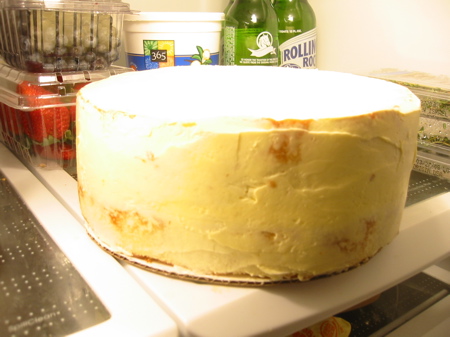
…and let it chill until you’re ready to decorate it, which will be, you know, just after you polish off a couple of those beers back there.
So, I’ve read in multiple places that frozen cakes are easier to handle and to decorate, but I’ve always worried about weeping problems. Can you always get away with decorating frozen? What about a poured fondant frosting? What about really hot, humid weather? What about poured ganache? And should you let the cake thaw after the crumb coat, or can you apply the final decorations while the cake is still frozen? Mind you, this question has always been somewhat academic for me, as there is never, ever room in my freezer for cake layers, but still – one day I’ll get a standing freezer.
Hi Nicole!
Good questions all. Cake layers won’t weep if they’re frozen. In fact they freeze beautifully. Just make sure to wrap them well so they don’t pick up odors. However your concerns about low temperature on icing and fillings is well founded. Usually, once I’m done trimming and assembling, the layers are already well on their way to thawing out. Buttercream can handle those semi-frigid temperatures (it firms, but as long as you work quickly that’s not much of a problem. But I always let the cake warm up before I apply the final layer of frosting. That’s especially true for a ganache or poured fondant, which would be wrecked by cold temperatures.
Thanks for the email!
I have heard about wiping the cake board with alcohol to sanitize it and keep the cake from molding. Do you think this is necessary and if you think this is a good precaution, how would you go about it? Do you mix the alcohol with some water first and than wipe it on board and will you have to dry it out? Also is that isopropyl alcohol or something like vodka?
Hi Lani!
In fact I’ve never heard of that. It makes some degree of sense, since the bottom of a cake is open and can come in contact with a work surface. I generally don’t let that happen, I put a cardboard cake circle under the bottom layer, mostly so the cake is easier to work with.
Regarding bacteria, most cake batters are so sweet that bacteria have a very, very hard time growing in them. I don’t see them as a food safety risk under normal circumstances (i.e. no raw meat, eggs or shellfish on the board before the cakes goes down).
Hope this helps!
– Joe
Hi Joe! After adding a crumb coat and then frosting/decorating entirely, I want to put my cake back in the fridge until ready to serve. (So the icing doesn’t bleed into the layers when I cut.) BUT I’m particularly nervous that refrigerating it will cause the cake to dry out, and I despise cakes that aren’t moist. Blech. So, my questions are: (1) Would the fridge dry out the cake? And if not, (2) How far in advance do you think I could get away with making/refrigerating a cake before serving? Obviously, I’ve never refrigerated my cakes before – but I see it in cake shops all the time! Thoughts?
Hey Jes!
Never fear, your cake will not dry out in the fridge, especially with a crumb coat on it which acts like tupperware. Yellow cake layers will hold for at least a couple of days like that. If you’re nervous you can paint on a little cake syrup for insurance before you apply the crumb coat. Don’t do too much since wet cake layers are just as nasty to me! But a couple of ounces per layer will ensure a moist product!
Have fun and let me know how the cake turns out!
– Joe
Joe,
Do we need to peel the top crust of the bottom cake before putting on the cream? I’ve seen layered cake slices and — especially with light-colored butter cream– the unpeeled crust shows brownish lining in between the layers which kind of ruined the beauty of the cake. What do you think?
If peeling is preferred, any tip on how to do it easily?
Thanks!
Katzies
Hey Katzies! Yes I trim off both of the top crusts. I like to freeze the layers then use a long serrated knife (you can also use a specialty knife called a “cake saw”) and gently slice it crossways. Does that help?
– Joe
Yes!
The cake turns out very professional!! Thanks Joe!
A big fan,
Katzies
I learned from you how to crack opera cake when I didn’t know a difference between genoise and joconda! I’ve gone a long way since, and I am forever indebted!
You made my day, Katzies!
Thanks so much for the delightful comment. Send pictures one of these days!
– Joe
Joe,
Thanks for doing a wonderful job by helping novice bakers like me. This website is my go to reference for anything regarding pastries. Do I have to torte the cake before freezing or after?
Thanks again
Saki
Hey Saki!
Thanks very much! Do you mean “trim”? If that’s what you’re asking, then definitely freeze it first since that will make the whole process easier!
Cheers,
– Joe
Also , please help me with this.
I am having my daughter’s birthday party on Saturday. Planning to do castle cake and bake the cake a week before. Can I do this,
1. Once the cake cools completely , freezing it.
2. Thursday, taking the cake out of freezer, thaw at room temp for an hour , then torteing, leveling , raspberry filling and Swiss meringue butter cream crum coating. And cover loosely with plastic wrap and keeping it in refrigerator for overnight .
3. Friday final frosting with Swiss meringue buttercream and other decorations. Then keeping the finished cake in refrigerator .
4. Can I make Swiss meringue butter cream 2 days before( that is on Thursday)?
5. Also does keeping the cake in refrigerator makes it dry?
I know I am troubling with too many questions but please help me .
Thanks
Saki
No problem, Saki!
Your plan sounds great. You can make buttercream ahead, however you’ll probably need to re-beat it if it’s been stored in the refrigerator. You’ll need to let it warm completely to room temperature first. If it breaks during the beating, just keep the mixer running until the temperature evens out and the buttercream fluffs up again.
Otherwise you’ll want to freeze the cake before you trim it, since that’s really the point of the freezing. Keeping the cake in the refrigerator will not make it dry, you don’t need to worry about that.
Have fun!
– Joe
Thanks for really very quick response. You are always an inspiration.
It’s my pleasure! Let me know how it turns out!
– Joe
i made a cake i put it in a ref after crumbcoating and i thawed it for 1 hour before puttng a fondant but after putting a fondant around it and while decorating the fondant began to sweat and little by little the fondant collapsed pls help me what is the problem and what will i do so that it will not happen again.
If you covered the crumbcoated cake with plastic wrap, it would sweat as it warmed, and when you put the fondant on, the moisture transferred to the fondant. Same thing happened to me recently. I had a huge air pocket on the top next day. The frosting cannot be wet when you put the fondant on. You want to be able to move the fondant around if need to. One cake artist said to stick a straw down into the middle of the cake so that when the cake settles, the air would take the path of least resistance and go out through the hole. This would help with the bulges in fondant.
Well done, Brenda. Thanks!
– Joe
Hi there,
I’ve seen conflicting responses. I plan to do two coats of buttercream before applying fondant. I will let the first layer set up in the fridge for a bit, but am I to do the same with the second layer? I’ve read that the fondant needs something to stick to, so you should apply the fondant immediately after that second layer. Is this true? Also, how do you store your cakes when freezing?
Thank you!
I also saw that you said ganache is ruined with cold temperatures. If I use a ganache filling, crumb coat my cake, and refrigerate, is this going to ruin it?
Hey Heather!
If I’m going to fill a cake with ganache, a whipped ganache is the better choice. It’s not nearly as sensitive to cold, though like any ganache you don’t want to get it too warm. It’ll do just fine in the fridge, but then a standard ganache will be fine as well, honestly. Factors like sheen don’t matter nearly as much for a filling as they do for a coating!
– Joe
Thank you for the quick response! So if I leave my Ganache filled cake out of the fridge for a day it would be OK? Also could you respond to my initial post questions? I’m making my cake tomorrow. Thanks!
Yep, the filled cake is fine in the fridge. Also which question didn’t get a response? Hm. I’ll go have a look.
– Joe
Hey Heather!
I’d let the second layer firm as well in the fridge before the fondant, otherwise the surface will be too slippery.
As for the freezing, are you planning to freeze the entire finished cake? Because that’s not advisable as the textures of the buttercream will change and the fondant will probably also crack. Individual layers can be frozen for several months by simply wrapping them in plastic wrap.
– Joe
Joe,
I am baking shower cake for a friend this weekend. I am wondering about baking/ freezing a cake. I am going to be out of town on Saturday until about 9 pm and the shower is on Sunday morning at 10 am. What is my best way to go about freezing, thawing, and then decorating a cake? It is 1/2 sheet cake with two heart cakes on top (equiv. to 2-8in rounds). How long will it take to thaw and how long until I can decorate it?
Thanks!
Hi Dionna,
You can prepare and freeze the layers any time between now and then. I generally prefer working with frozen layers when it comes to trimming and building…you don’t have to worry about cracking quite so much. You can apply fondant and decoration when the layers are frozen, no problem. You’ll notice that it doesn’t take long for them to thaw. Probably by the time you’re finished applying your last frills the whole cake will have thawed. Generally even a fully decorated frozen 9″ layer cake will thaw in a couple of hours at room temperature. Does that answer your question?
Cheers and best of luck with the project!
– Joe
Wow, thank you for your amazingly quick response! One more question, if I am freezing it in my “everyday” freezer, how many layers should I wrap it in if it is just for 4days. Thanks again for your help! I have never froze a cake before (can you tell!)
Hey! No problem. One layer of plastic is fine for that amount of time provided there’s nothing especially smelly in there! If so, wrap it again!
Cheers,
-Joe
I apologize for my last comment, I typed it using a microphone. I was in a hurry and obviously it did not type it well.
Let me try again (please delete old comment)
I plan on cutting both layers in half to make a four layer cake. Is this best done frozen or before I freeze it? And should I freeze it while still warm or cool?
Hi Elena!
Both good questions. It’s best to let cake layers cool completely before you freeze them — but they will be much easier to cut when they’re frozen. You can manipulate the more rigid frozen layers without fear of cracking or crumbling. Let me know how your project goes!
– Joe
I am making a wedding cake. I would like to bake and fill, and crumb coat the layers and freeze first, then decorate the night before the wedding. Can I decorate the cake layers while Frozen? Can I put the dowels in the cake before freezing? We are trying to do as much as possible before the wedding.
Hello Victoria!
Good questions! You can certainly freeze the layers first, though I wouldn’t advise filling first, unless your filling is a jam with perhaps a scraping of buttercream underneath (which would survive the freeze process). A buttercream crumb coat would also survive freezing. It will break some, but then you’re going to cover it up anyway, so no harm done. Cake layers do thaw quickly, so yes, you can indeed apply your final buttercream coat and begin decorating while it’s frozen. Your buttercream will firm as you apply it, but that’s generally a good thing. You can also push dowels into the frozen layers if you like.
What sorts of fillings and frostings do you intend to use if I may ask?
– Joe
The bride has requested a chocolate cake with raspberry filling. I just read your reply and have just put the cakes a 12, 10 and 8 inch round in the freezer, filled and crumb-coated. Hopefully this works have done this before and it worked, but I used a Bavarian cream filling then. The wedding is on Saturday 2 weeks from now, and we decorate the cake on Friday night. When would you suggest taking it out to thaw, or perhaps decorate frozen on Friday night and should be thawed by Saturday night?
I am making a cake for the first time and it has a cream cheese frosting. Is it ok to frost the cake while frozen with the cream cheese frosting? I know it has a different texture and wasn’t sure if it would affect anything.
Hi Michelle!
You can indeed decorate layers just out of the freezer with cream cheese frosting. The layers thaw suprisingly quickly as you work with them so there’s no risk of the frosting actually freezing. (Just don’t freeze the cake after you frost it). Have fun with the project!
– Joe
Hi joe,
I have a question about the Italian Meringue Buttercream and covering a cake.
Do you know how to get the IMBC a lovely uniform colour all over the cake? I am making a Wedding Cake soon, without colouring the IMBC, and I have always had this trouble, where I will crumb coat the cake, then let harden in the fridge or freezer, then do another layer, and sometimes another if it needs it. But because of the Butter hardening and defrosting, it creates that unwanted yellow stain on the coatings. Nobody seems to notice…but i feel if it were on a larger cake, it would be very noticeable.
Btw…your website is incredible, has helped me heaps, throughout my baking!
Hello Samantha!
Thanks very much for your generous comments! I have had that problem as well with buttercream that has a color of any intensity. Honestly I don’t know what causes that. Any chance you can apply the last coat without refrigerating the cake?
– Joe
Ah! That’s a really good idea, I wouldn’t have thought of that, Ill give it a shot today 🙂
Thankyou!
Let me know how it goes, Samantha!
– Joe
Hi joe..if I intend to freeze my cake for like upto 2 weeks with whole fondant decorations on it …I wrap it tightly with cling film and freeze..should I consider frozen poultry or meat. Will they have any chemical reactions or bacteria to transfer or odor to it
thanks…
Hi Joe! What’s the best type of cake under fondant and tier cakes. There are so many cake recipes on internet but how will i know which is recommended for fondant. Thanks 🙂
Hi!! I made a 9″ four layer cake for a baby shower in one week. I baked and crumb coated, and will freeze now until next weekend… Is this ok? Should I wrap? Also, can I remove from freezer, thaw, and decorate two days prior to party, and refrigerate until party? Is that the best plan? Thanks!!
Yes that’s OK Allison!
If the buttercream in the crumb coat breaks a little when it thaws no biggie…it’ll get covered up. Wrapping is probably a good idea especially if there are any off smells in the freezer. The buttercream and the cake will absorb them.
As for thawing, that’s a good plan. Two days shouldn’t be a problem at all assuming the buttercream your using doesn’t dry too much. If it’s quite buttery you’ll have no problem at all. If it’s rather very sugary like an American buttercream you might see a few small cracks in the detail work, but it won’t be a disaster. Does that help?
Best of luck!
– Joe
Hi there,
Love your site!
I have a question I hope you can answer… I am making a large “novelty” cake covered in fondant. I plan on freezing all the component cakes, but once assembled on the board for crumb coating they won’t fit back in the fridge. So I thought that once it is thawed, I should apply the crumb coat, then the final coat of icing and then the fondant and decorations ASAP. So essentially the day before the event (to cut down stress the day of!)
My question – how best can I store my fondant covered cake without causing elephant skin (drying out) overnight? Can I loosely drape plastic wrap over the whole lot? Can anything be done to fix it if it does happen?
Also, since I can’t refrigerate, would you recommend a butter cream or a ganache crumb coat? Or is it just a matter of taste?
Do I need a second layer of icing over the crumb coat before I lay the fondant, or can I lay the fondant directly onto the first crumb coat?
Sorry for all the questions, your advice is always so good!
Hey Mich!
Thank you for that last phrase, do me a favor and emphasize the point the next time you see Mrs. Pastry.
On the cake, so much depends on the fondant itself. If it has glycerine in the mix, odds are you can simply store it on the counter and you won’t have a problem. If there’s any humidity at all, you shouldn’t have a scaling problem for 36 hours or more. To that point, don’t apply plastic wrap since any moisture that does collect under it will cause the plastic to stick.
Regarding crumb coats either will work. I generally prefer buttercream, but a whipped ganache will have the same consistency and no raw egg worries.
Let me know if you have any other questions — and good luck!
– Joe
Hi Joe. I am making a fondant covered novelty cake for my grandson’s birthday. We need to make the cake on Saturday but won’t be using it until Thursday. Since it is covered in fondant, can it just sit on the counter loosely covered to keep dust off? I don’t want the cake to be stale nor do I want sweating since I’ll have buttercream under the fondant. Not sure what to do with it. Thanks!
Joe,
I baked a two layer cake on Saturday and filled it with buttercream. We crumb coated it with buttercream and frosted it with buttercream. I froze the entire cake without wrapping it until Tuesday. I took it out of the freezer about 4 hours before the party and it began weeping. Can you tell me what I did wrong?
Thanks,
Cindy
Hey Cindy!
It was the freezing that did it. When buttercream is frozen it needs to be re-whipped to prevent the very thing you’re describing. Refrigeration is the best way to keep a cake if you need to. They’ll generally hold for several days after they’ve been built and frosted. A little cake syrup will help stave off any staling of the cake layers themselves. Sorry for the problems, I bet it still tasted great, though!
Cheers,
– Joe
Hi Joe,
My son told his fiancée I could make their wedding cake. I do enjoy baking, and was flattered they asked, but.. Yikes! I’m making a small 4 layer, 2 tier wedding cake (10″ & 6″).. I’ve made many cakes but never a wedding cake (I’m on my third practice one). The bride has requested rose swirls covering the entire cake. The wedding is in the Sacramento, CA region and I expect it to be 100 degrees by the end of June. I live at a higher elevation where it’s much cooler. The cake will be indoors, but transportation will be over an hour. Question… If I complete the cake the day before the wedding and refrigerate overnight, will the crusting buttercream frosting sweat, or should I do the rose swirls the busy day of the wedding? Thanks. Judy
Baked cakes for 30 years (not professionally by any means) for family and friends, but never froze them. I am making an 11×15 cake with a 1/2 basketball on top for my grandson’s birthday Saturday. Never baked a cake like this. Do I HAVE to freeze it for it to come out right when it’s larger like this or can I bake the cake tomorrow afternoon and decorate it when it cools like I always have with smaller cakes in the past. No fondant. Just good ol frosting with decorating tips. Also, any tips in getting a larger cake like that out of the pan successfully?
Thanks!